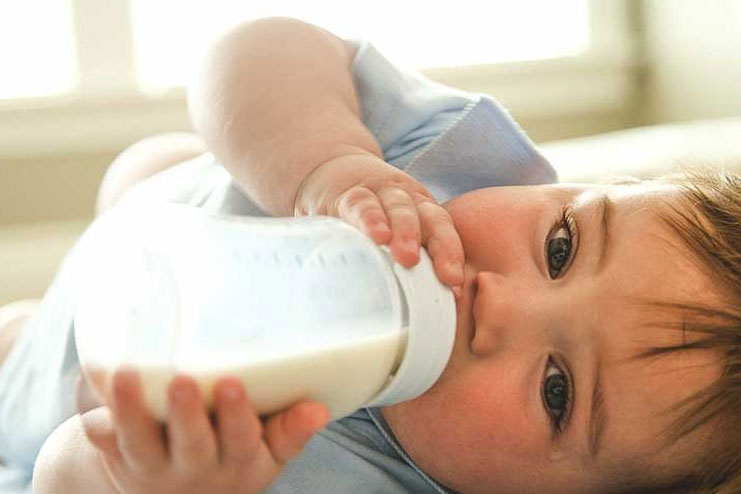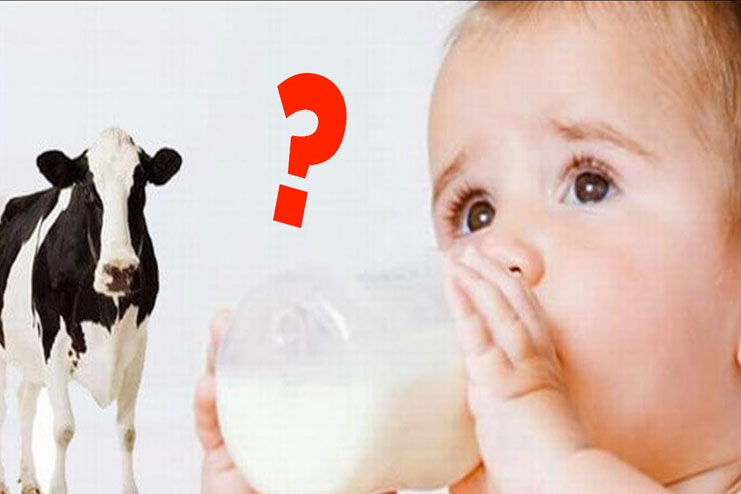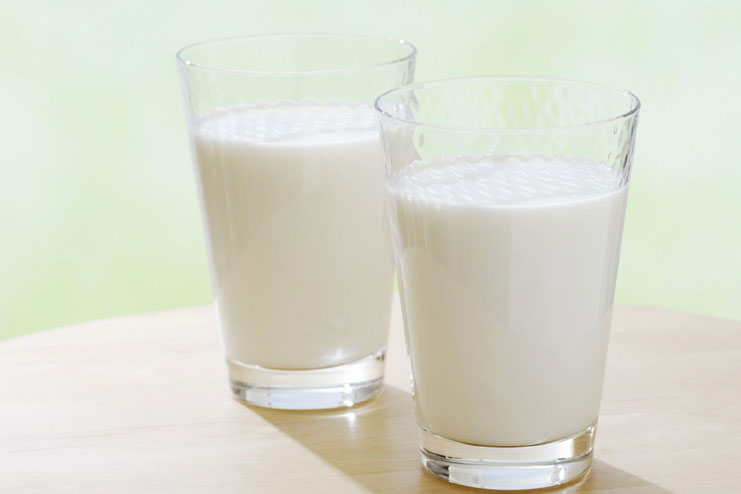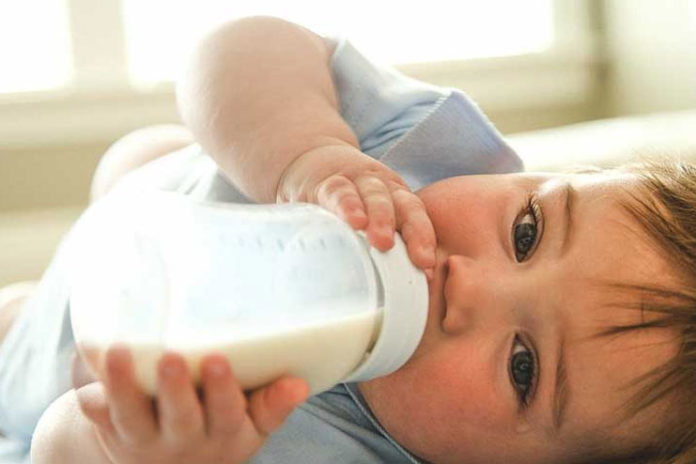Cow’s milk with its great nutritious value has become a part of baby’s diet. Many parents doubt whether the cow’s milk is safe for the kids or not? when is your baby ready to digest cow’s milk and how much quantity is required? How to transition your baby from breast or formula milk to cow’s milk? Keep reading this article to find the answers.
This article discusses the benefits of cow’s milk. It presents the ways to switch baby to cow’s milk.
Benefits of Cow Milk For Baby:

Children who eat vegan food may not get enough nutrients like protein, calcium, omega-3, iron and several other nutrients which are required for their proper development. Animal products are required to ensure that the baby’s are getting enough nutrients they need.
Diary products especially play a prominent role in nourishing your baby.
Nutritious cow’s milk provides the following benefits to the baby:
1.Improves Muscle Growth:
Cow’s milk provides babies with the high proteins which are required for the healthy muscle synthesis and development. Babies require proteins which help them repair cells, enzymes, hormones, and to provide energy.
2.Improves Brain Health:
Cow’s milk is the rich source of vitamin B which helps in calming down the nerves thereby allows your baby to have proper sleep. Vitamin B12 improves memory and plays a vital role in healthy brain function.
3.Builds Strong Bones and Teeth:
Milk is rich source of calcium which plays a vital role in strong bones and teeth. It also helps in regulating the blood clotting and muscle control. Being a source of vitamin D, it plays a vital role in bone development. Enough amounts of calcium keep the baby away from the risk of blood pressure, stroke, colon cancer, and fractures in later life.
4.Helps Circulatory System:
Regular consumption of milk keeps the blood pressure in control thereby benefits the overall circulatory system. Cow’s milk helps in keeping the heart healthy by maintaining blood pressure. It has essential acid known as Conjugated Linoleic Acid (LCA) which lowers the growth of bad cholesterol thereby keeps the heart healthy.
5.Good for Weight Loss:
Healthy fat content cow’s milk helps in reducing the weight. It makes your baby’s tummy feel full and avoids sudden pangs.
6.Helps baby’s general Health:
Milk is a source of a wide range of micronutrients including vitamins, minerals and trace elements making it a complete food for babies.
When should I introduce cow’s milk to my baby?

The question of many parents is whether to give formula milk or cow milk after 1 year? Switching baby to cow’s milk depends on your baby’s taste preference. It is absolutely fine to feed your baby either of the one. If your baby could not tolerate fresh milk continue feeding the formula milk.
All the babies may not like the milk. Especially breastfed babies are more reluctant to drink cow’s milk, that’s absolutely fine and breastfeeding is encouraged as long as the mom wants to breastfeed her baby.
When it is safe to feed a baby cow milk? You can give your one year old baby 3.25 % homogenized cow’s milk when they start eating a variety of iron rich foods twice a day. Offer the milk in a regular cup instead of using a sippy bottle which helps the baby to learn how to drink.
Wait until your baby is at least 12 months. Before the age of 1 year babies cannot digest the cow’s milk as easily as breast or formula milk. Cow’s milk with its high concentrations of protein and minerals will impact the kidneys adversely.
Serve the solid meals and healthy snacks in between before offering a cup of milk.
How Much Cow’s Milk to Feed A Baby?

When you transition your baby to cow’s milk, start with 2 cups counting to 500 ML per day. Make sure that it should not exceed 750 ML per day. Drinking a lot of milk keeps your baby;s tummy full leaving less space for the remaining food.
You can also offer dairy equivalent foods like yogurt or cheese to your baby. Never offer the milk as a substitute for meals. Cow’s milk is the optional nutritional supplement beverage. You can feed your baby other foods with the same nutrients.
What Happens If You Give Cow’s Milk to the New Born Baby?

Giving your baby cow’s milk before 1 year is not recommended for the following reasons:
- Cow’s milk is a rich source of protein. Babies’ immature digestive systems are not enough to digest the large quantity of proteins.
- Newborn baby’s digestive systems are intolerant to cow’s milk
- Cow’s milk is unlikely to contain the nutrients required for the growing babies.
- Cow’s milk makes the baby iron deficit as it absorbs the iron in the body.
Side Effects of Cow’s Milk in Toddlers:

It is better to monitor your baby for any side effects if you introduce any new solid food. The same rule applies to the cow’s milk as well.
As milk is rich in proteins, sodium, calcium, and vitamin D sometimes your baby’s digestive system feels hard to digest. You can observe symptoms such as diarrhea, vomiting, relentless crying, flatulence or sounds in the bowels when your baby’s digestive system is strained.
Here are the few side effects of cow’s milk in toddlers:
1. Type 1 Diabetes:
Proteins are necessary for growth. But, milk being the rich source of high level proteins and some of these proteins makes the kids vulnerable to Type 1 diabetes by stimulating the autoimmune reactions.
2. Allergy:
Cow’s milk allergy may be the reason for your baby’s inconvenience. Your baby may be at the risk of following allergies:
- Skin allergies like rashes, hives, eczema
- Breathing problems like wheezing like asthma.
There are some other symptoms which slowly affect your baby. They are:
- Irritability
- Diarrhea, and vomiting
If the babies come across these kinds of allergies, breastfed babies are recommended to continue breastfeed and formula fed babies are advised to try soy-based formula as an alternative.
Visit your doctor immediately if you notice the following signs:
- If your baby is extremely pale or weak
- Has hives all over his body
- Has swelling in the head and neck
- Bloody Diarrhea
3. Lactose Intolerance:
Babies who are intolerant to milk will have the symptoms of bloating, gas and loose stools. Intolerance is caused when a baby’s digestive system cannot properly break the lactose into simple sugars.
4. Childhood Constipation:
Many children suffer with constipation. Studies (R) show that constipation results from the intolerance of cow’s milk.
5. Affects Baby’s Immune system:
Babies have immature digestive systems. High levels of nutrients present in the cow’s milk strains the digestive system thereby leading to many side effects.
How to Choose the Right Cow Milk for the Babies?

The most general query of parents is what kind of cow milk for baby? Here are the few features to take into consideration:
1. Pasteurized and Sterilized:
Pasteurization is the process of heating the bacteria at high temperatures and then rapidly cooling down it to the normal temperature to reduce the bacteria and other microorganisms in the milk. Sterilization kills the microorganisms in the milk. Sterilized milk is best preferred over the pasteurized milk but pasteurized milk can be considered if sterilized milk is not available.
2. Fortified:
The addition of nutrients to increase nutritional values in the milk is known as fortification. Fortification helps the babies to attain required nutrients.
3. Choose Whole Milk:
Skimmed or low fat milk contains low nutrients that are not enough to meet your baby’s requirements. Low fat and fat free milk contain low concentrations of vitamins and minerals making whole milk a better option. On the other hand, skimmed milk contains high concentrations of Protein, potassium, sodium, and chloride, which can overload baby’s kidneys.
How To Introduce Cow’s Milk to Babies?

As cow milk is hard to digest, introduce it slowly to the baby, here are the few ways for switching baby to cow’s milk:
1. Start with Small Sips: Babies may not show interest in newly introduced foods. Use a sippy or open cup to introduce the milk in small amounts. It helps the baby to get used to the taste of cow milk.
2. Check with your pediatrician:
The first step to take while introducing the baby to cow’s milk is to check with the pediatrician. Follow the guidelines provided by your doctor.
3. Limit the Juice and other beverages: Reduce the intake of juices and other sugary beverages to make your baby drink milk.
4. Give Cow Milk in a separate Cup:
While introducing the cow milk to the baby for the first time, do not mix it with any other food. Serve it in a separate bowl which allows the kid to feel the taste of the milk.
5. Make it a part of meal:
Serve milk following the morning breakfast and evening meals. It can serve as a part of little amounts of daily meal plan to reach the nutrient demands of your baby.
6. Ease the process: If your baby does not like cow milk. Then make it interesting by combining whole milk either with breastmilk or formula milk. Gradually start decreasing the proportion of breastmilk/formula milk.
7. Serve Cow milk in interesting cup or bottles:
This is one of the best ways to introduce cow’s milk to baby. Serve the milk to your baby in a bright colored cup printed with the appealing cartoon character. If your baby still drinks milk in a bottle, consider replacing it with a cup.
8. Offer at Ideal Times:
An irritated baby may not accept the food offered by you. Ensure that your baby is happy and rested when you offer the milk. Offer it as soon as the baby wakes up and offer it as the snack in between meals.
9. Increase quantity slowly:
If you give the baby the milk for the first time, start with the small amounts. Wait for two days before increasing a bit more.
10. Heat the Milk:
Never offer the cow milk cold. Heat the milk gently to temperature before serving the baby to give it the taste similar to breast milk and formula milk.
11. Add Cow’s Milk to other Foods:
If your baby rejects the cow milk then start mixing it with other foods which your baby enjoys like- mashed potatoes, cereals, and soup etc.
12. Offer Supplements:
If your baby is not showing interest in drinking milk then start offering other dairy products like yogurt, cheese.
13. Give your baby Warm Milk:
Most of the babies prefer warm bottle. This is because the babies are habituated to breastmilk which is at the normal body temperature. Prefer feeding them warm milk or keep the milk bottle taken out of the refrigerator in a sink of warm water for few minutes before giving it to the baby.
Cow’s milk works well for the babies transitioning to toddlerhood. It helps the babies to attain the recommended dietary allowances of nutrients easily. Safely make the cow milk as a part of your baby’s diet by following the 13 best ways to introduce cow’s milk to babies.









































